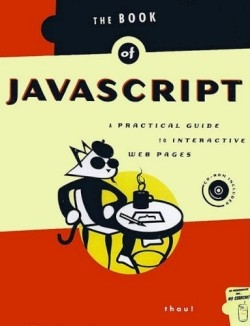The Book of JavaScript
A Practical Guide to Interactive Web Pages
JavaScript is to web pages what fourth generation languages were to mainframe computers in the seventies and eighties. It allows web pages to pass information to and from computer programs on web servers. JavaScript has the ability to read what a website visitor has entered into a form, perform a mathematical calculation based on the input, and provide feedback by displaying the results in another part of the form. It can be used to calculate a monthly payment on a loan, score an exam, or verify a visitor’s e-mail address. Best of all, it doesn’t require a programming background.
The Book of JavaScript is ideal for people who are intimidated by the thought of writing code. It explains in truly basic terms the functions of programming language. Numerous figures and screen prints illustrate the examples explained in the book and make it easy for readers to copy the commands directly from the book into their own programs. It also incudes a CD that contains many useful scripts that can be modified to meet readers’ specific needs. The “Tripod” file, for example, demonstrates use of a pop-up window for separating advertisements from the content of a web page.
This book bridges the gap between reference guides and tutorials in that it contains elements of both; it teaches the JavaScript language and illustrates practical applications of the scripts. Brief exercises at the end of each chapter walk readers through applying the principles discussed in the chapter by following examples and writing their own simple scripts.
A working knowledge of HTML is helpful but not necessary. JavaScript is the only web programming language that works directly with web browsers to access images, forms, and windows. The book candidly admits the limitations of JavaScript such as its inability to talk to servers or to create graphics. It does, however, explain how to get around these shortcomings and how to interface with different web browsers and other programs.
Thau is a senior scientist at Nerve (www.nerve.com) and a recognized JavaScript expert and educator. JavaScript achieves its goal of giving readers enough of an understanding of the language to interpret other people’s scripts as well as to write their own. This book is for those wanting to add a dynamic and interactive look to their web pages.
Reviewed by
Cindy Patuszynski
Disclosure: This article is not an endorsement, but a review. The publisher of this book provided free copies of the book to have their book reviewed by a professional reviewer. No fee was paid by the publisher for this review. Foreword Reviews only recommends books that we love. Foreword Magazine, Inc. is disclosing this in accordance with the Federal Trade Commission’s 16 CFR, Part 255.

